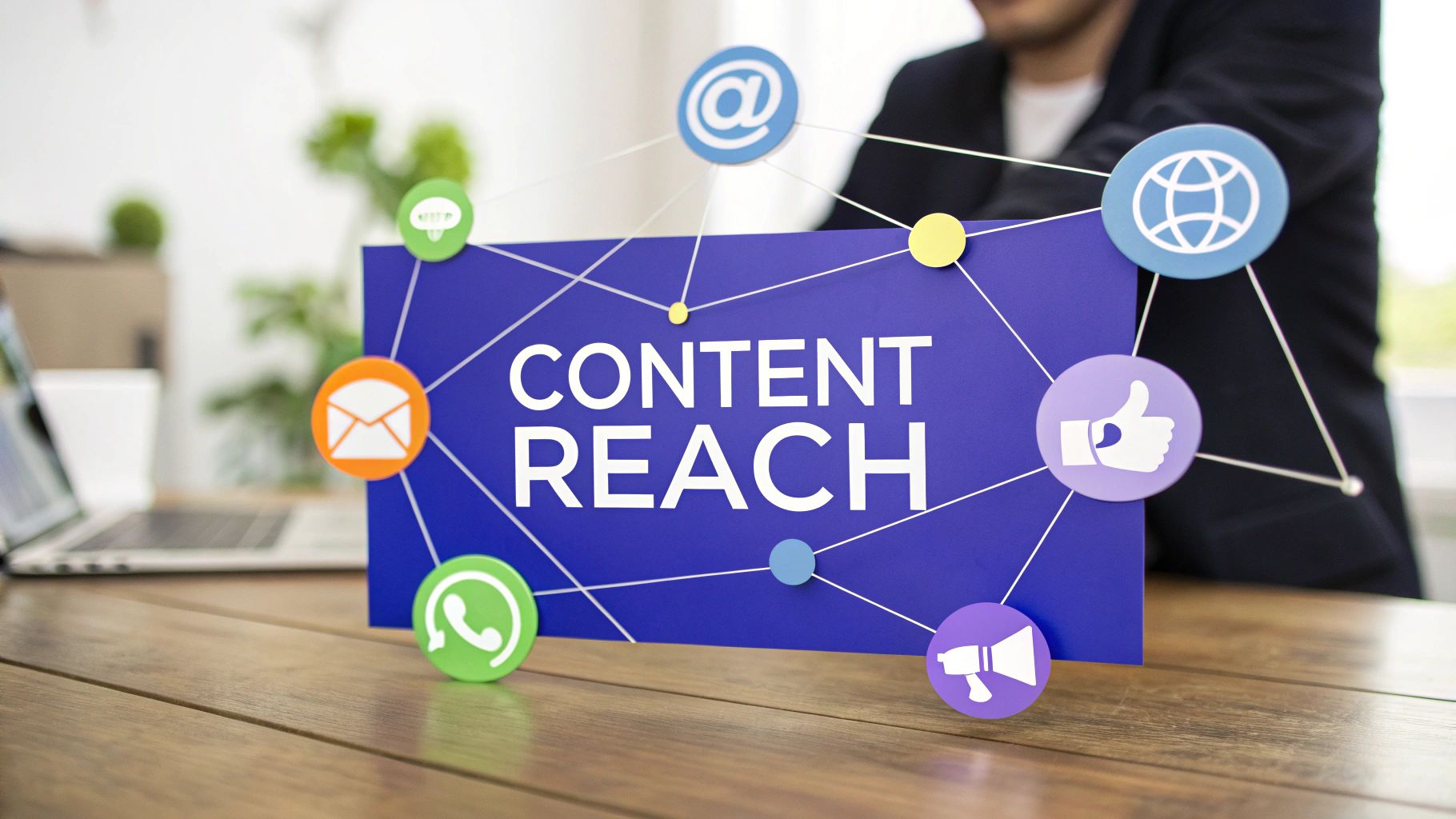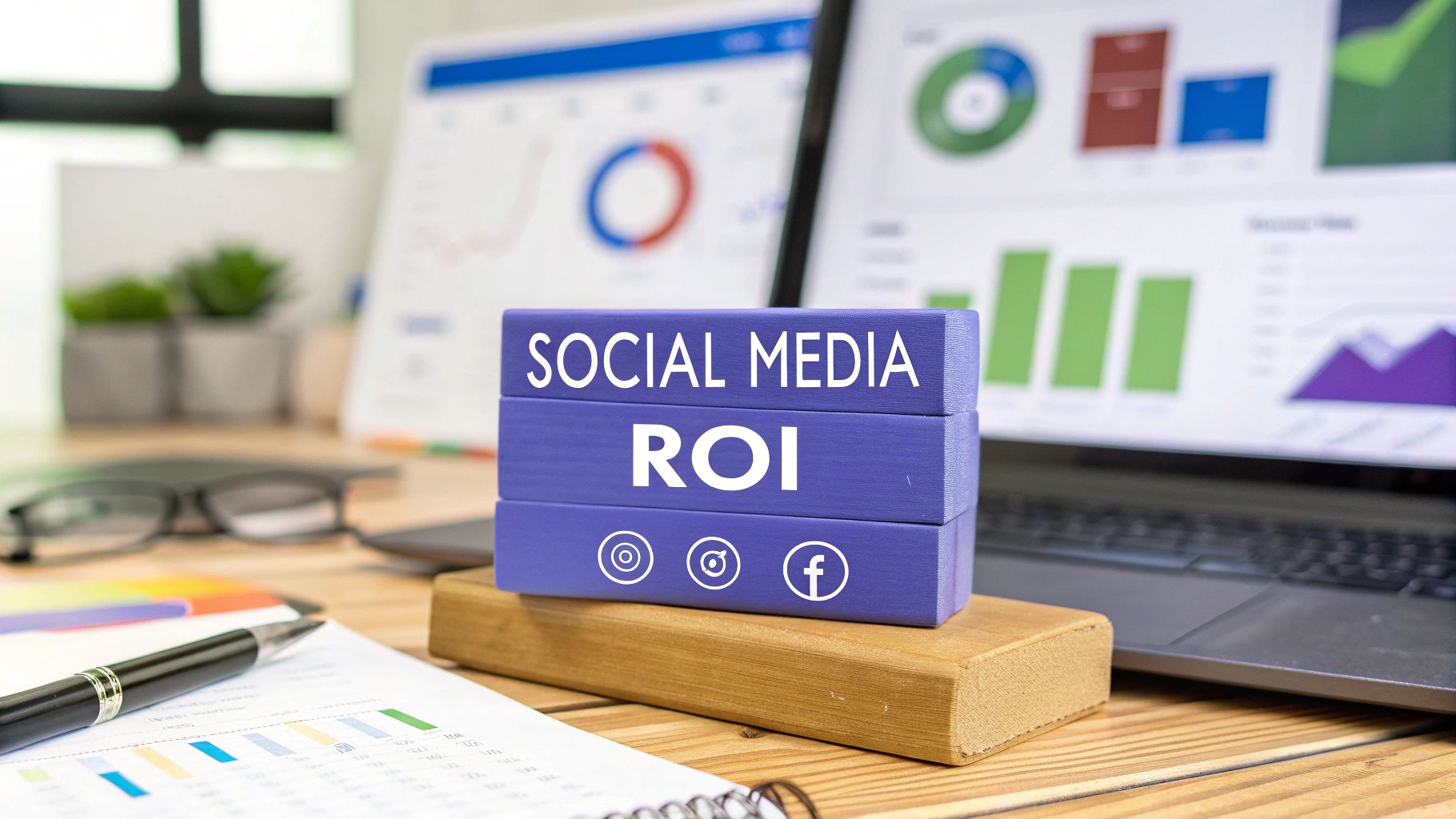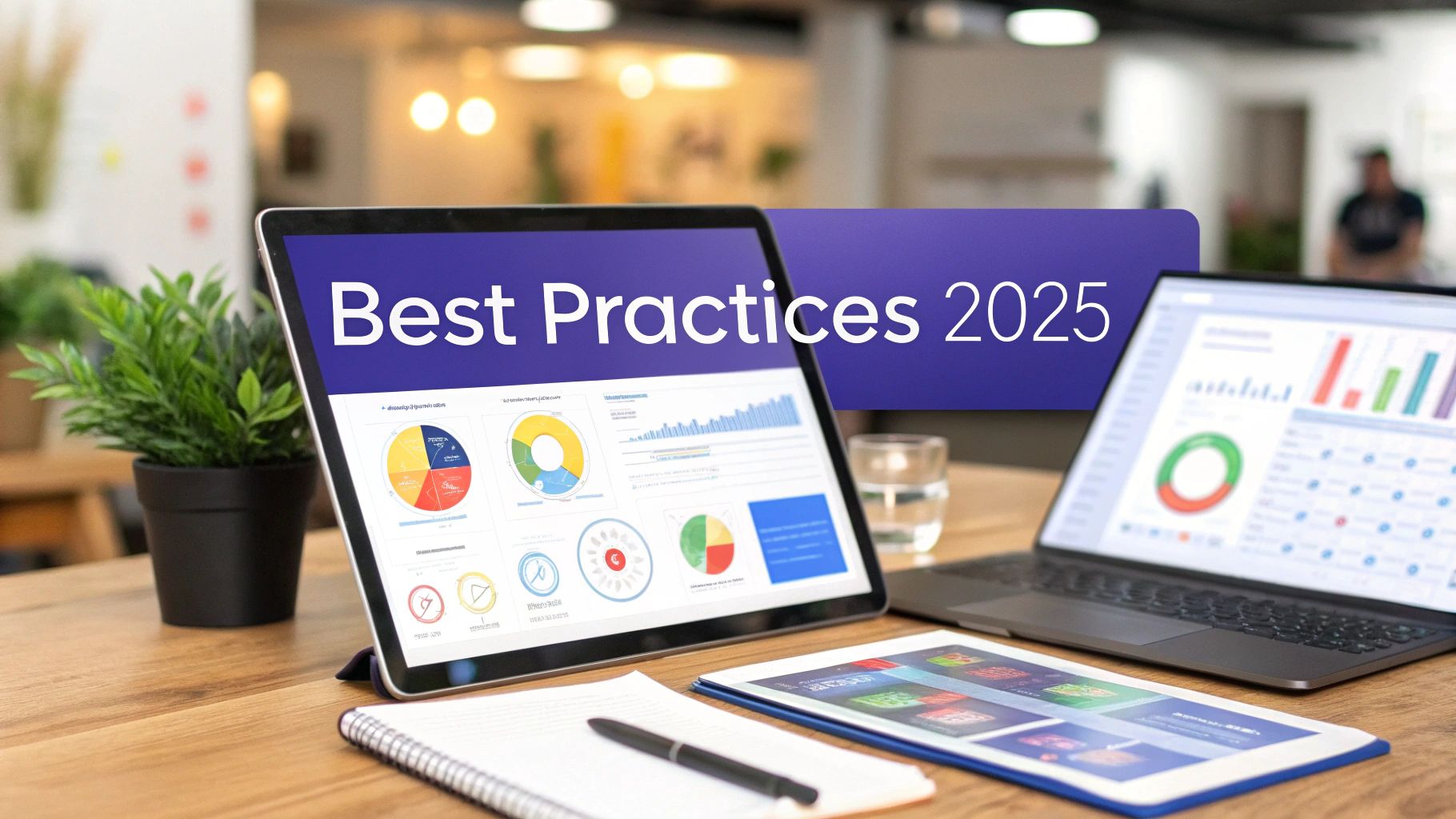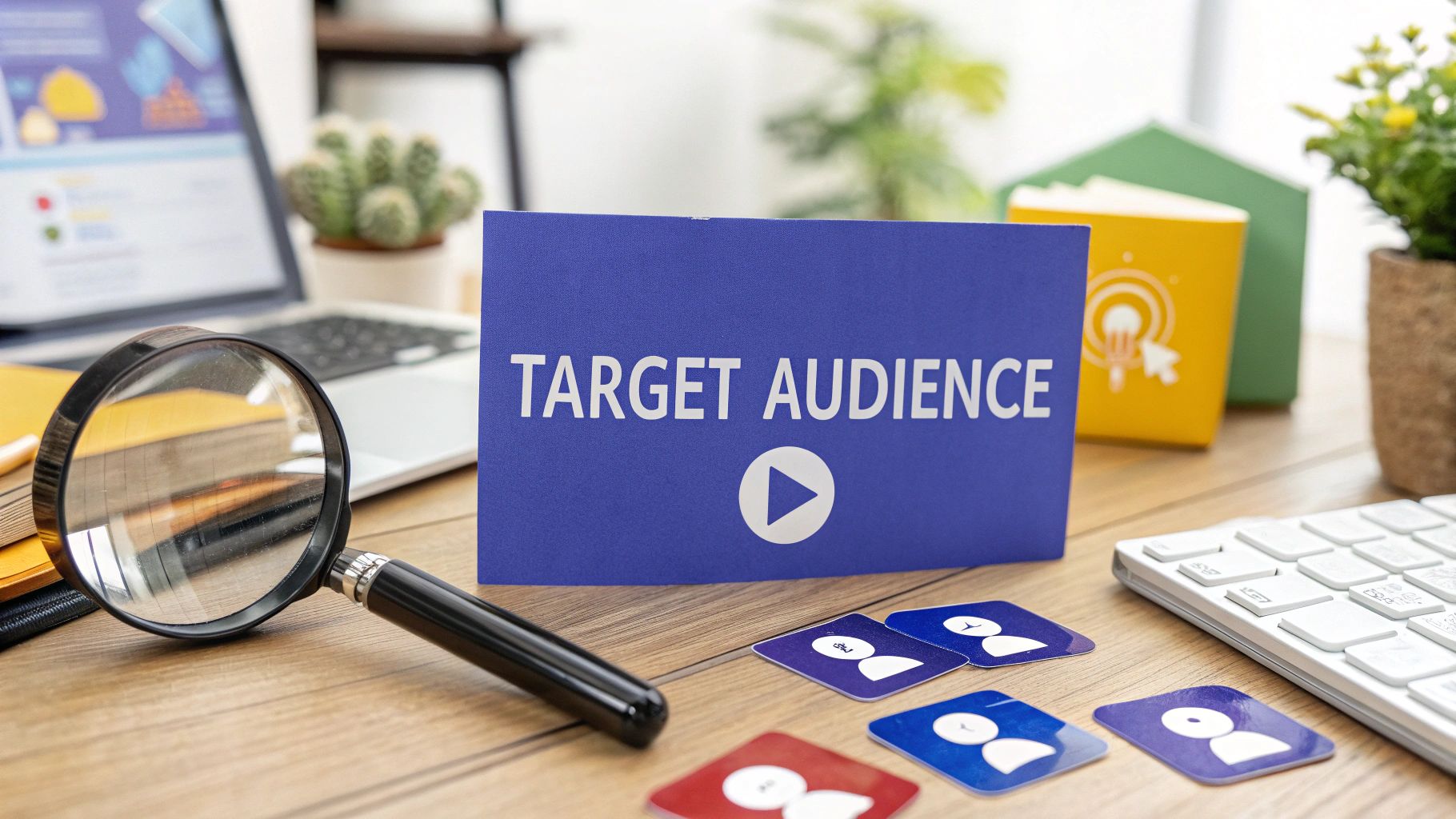A content distribution strategy is, quite simply, your plan for getting your content in front of the right people. It’s the roadmap you create for publishing, sharing, and promoting everything you make so it connects with the audience it was built for. Think of it as the crucial bridge between creating something amazing and actually seeing it drive awareness, engagement, and real business results.
Why Your Content Needs a Distribution Strategy
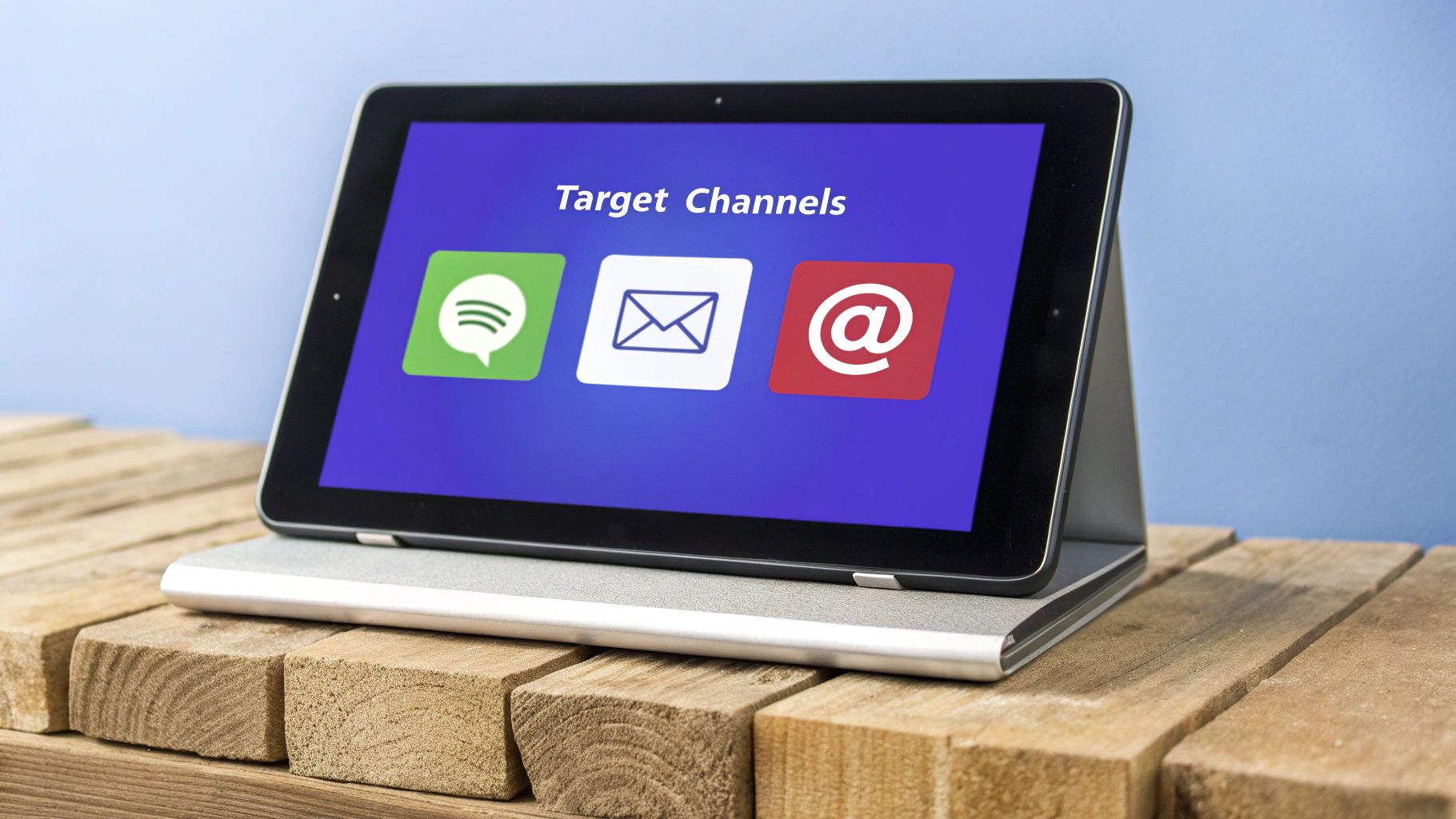
Let's try a little thought experiment. Imagine you spent months producing a cinematic masterpiece, only to lock it away in a vault where no one could ever see it. That’s exactly what happens when you pour resources into incredible content—blog posts, videos, or podcasts—but have no plan for sharing it with the world.
Without distribution, even the most brilliant content is just a file taking up server space.
A solid distribution strategy is what separates the "publish and pray" crowd from marketers who get consistent, predictable results. It’s about moving from a passive hope that people will find you to a deliberate system that actively seeks them out.
The entire point of a distribution strategy is to make sure your investment in content creation actually pays off. It’s about maximizing your visibility, connecting with your audience where they already spend their time, and turning your content into a reliable engine for growth.
When you skip this step, you're not just leaving views on the table. You're guaranteeing wasted resources, missed opportunities, and a brand that struggles to grow. A plan isn't just nice to have; it's non-negotiable.
The Real Cost of Neglecting Distribution
The digital world is loud. Incredibly loud. Just hitting "publish" is like whispering in a packed stadium and expecting everyone to hear you. A smart distribution plan is your megaphone, helping you cut through the noise to achieve real business goals.
Let's break down the foundational pillars of a great strategy.
Key Components of a Content Distribution Strategy
| Component | Description | Example |
|---|---|---|
| Target Audience | A deep understanding of who you're trying to reach. | Creating personas for "Marketing Managers" and "Startup Founders." |
| Content Formats | The types of content you will create and distribute. | Blog posts, short-form videos, podcasts, and infographics. |
| Distribution Channels | The specific platforms where you'll share your content. | LinkedIn, an industry newsletter, SEO, and paid social ads. |
| Promotion Tactics | The specific actions you'll take to amplify your content. | Email outreach, influencer collaboration, and social media sharing. |
| Goals and Metrics | The success markers you'll track to measure performance. | Website traffic, lead conversions, social engagement rate. |
This table outlines the core elements, but the real magic happens when you bring them all together. Here’s what a well-executed plan delivers:
- Builds Brand Awareness: A smart strategy gets your content in front of potential customers again and again, establishing your brand as a credible, go-to voice in your industry.
- Generates Qualified Leads: By focusing on channels where your ideal customers hang out, you attract people who are genuinely interested in what you do, not just random clicks.
- Fosters Customer Loyalty: Sharing valuable, helpful content is how you nurture relationships with your current audience, keeping them engaged and turning them into brand advocates. For a deeper look, check out this modern agency guide to content distribution strategies.
The stakes have never been higher. Worldwide content marketing revenue is on track to hit $107.5 billion by 2026. To keep up, 63% of businesses now put money behind their content with paid channels, and 83% of marketers see content as their number one tool for generating demand.
This isn't a trend; it's the new standard. To win, you need a structured approach to your channels—something you can easily organize with a social media marketing plan template.
Understanding the Core Distribution Models
A smart content distribution strategy isn't about throwing your content at a few popular channels and hoping something sticks. It’s a deliberate, calculated effort that blends three core models: Owned, Earned, and Paid media. Getting these three to work together is what separates a basic plan from a genuine growth engine.
Think of these models as different tools in your marketing shed, each designed for a specific job. You wouldn't use a hammer to saw a board, and you wouldn't run paid ads when you're trying to build deep, organic trust. The real magic happens when you combine them.
The most effective strategies don't just lean on one distribution model. Instead, they create a powerful ripple effect by blending Owned, Earned, and Paid media to boost reach, build credibility, and drive results far beyond what any single model could do on its own.
This integrated approach is often called the PESO model (Paid, Earned, Shared, Owned). "Shared" is usually seen as part of Earned and Owned media—it’s the organic word-of-mouth that happens on social platforms. Once you get how each piece works, you can build a strategy that’s both resilient and incredibly effective.
Owned Media: Your Digital Home Base
Owned media is everything you completely control. This is your home turf, the foundation of your entire content strategy. Here, you set the rules, you control the message, and you own all the audience data.
Your owned channels are where you build a direct line to your audience, no gatekeepers or monthly fees required.
Key examples of owned media include:
- Your Website and Blog: The central hub for all your most valuable, in-depth content.
- Email Newsletters: A direct link to your most loyal subscribers.
- Company Social Media Profiles: The accounts you personally manage on platforms like LinkedIn, Instagram, or X (formerly Twitter).
- Mobile Apps: A dedicated space for your community to interact directly with your brand.
The biggest upside here is total control. You’re not at the mercy of sudden algorithm shifts or rising ad costs. The catch? You have to build that audience from the ground up, which takes serious time and effort in things like SEO and community building.
Earned Media: The Ultimate Social Proof
Earned media is today's version of word-of-mouth. It’s the organic buzz and credibility you earn through trust and reputation, not by writing a check. This is what people are saying about you when you're not in the room, and it's pure gold for building brand authority.
This kind of media exposure is often the direct result of putting out fantastic content on your owned channels and nurturing real relationships in your industry.
Earned media usually shows up as:
- Press Mentions and News Coverage: When journalists or major publications feature your company or its research.
- Guest Posts on Reputable Sites: When you publish your expertise on other respected industry blogs.
- Customer Reviews and Testimonials: Genuine praise from happy customers.
- Organic Social Shares and Mentions: When people share your content simply because they love it.
- Influencer Mentions (Unpaid): When an influencer organically shouts out your product or content.
While earned media is incredibly credible, its main weakness is that it's unpredictable and you can't control it. You can't force a reporter to cover your story, but you can absolutely create the conditions that make it a no-brainer for them.
Paid Media: Your Megaphone for Reach
Think of paid media as your megaphone. It’s any channel where you pay to play, getting your content in front of highly specific audiences to fast-track your reach. When you need guaranteed, immediate traffic, paid distribution is your go-to tool.
This model is perfect for giving your best-performing owned content a major boost or for getting a new campaign off the ground with a bang. To truly get a handle on how these different models can work together, it helps to look into strategies for building an effective omnichannel customer experience.
Common paid channels include:
- Pay-Per-Click (PPC) Ads: Search engine ads on platforms like Google.
- Paid Social Media Ads: Boosting posts or running targeted campaigns on LinkedIn, Facebook, etc.
- Sponsored Content: Paying a publication to feature a story about your brand.
- Paid Influencer Marketing: Partnering with influencers for sponsored posts.
The biggest advantages are speed and scalability. You can launch a campaign and see results in just a few hours. The flip side? It costs money, and the traffic dries up the second you stop paying. It’s a rented audience, not an owned one.
Using Paid Channels to Accelerate Your Reach
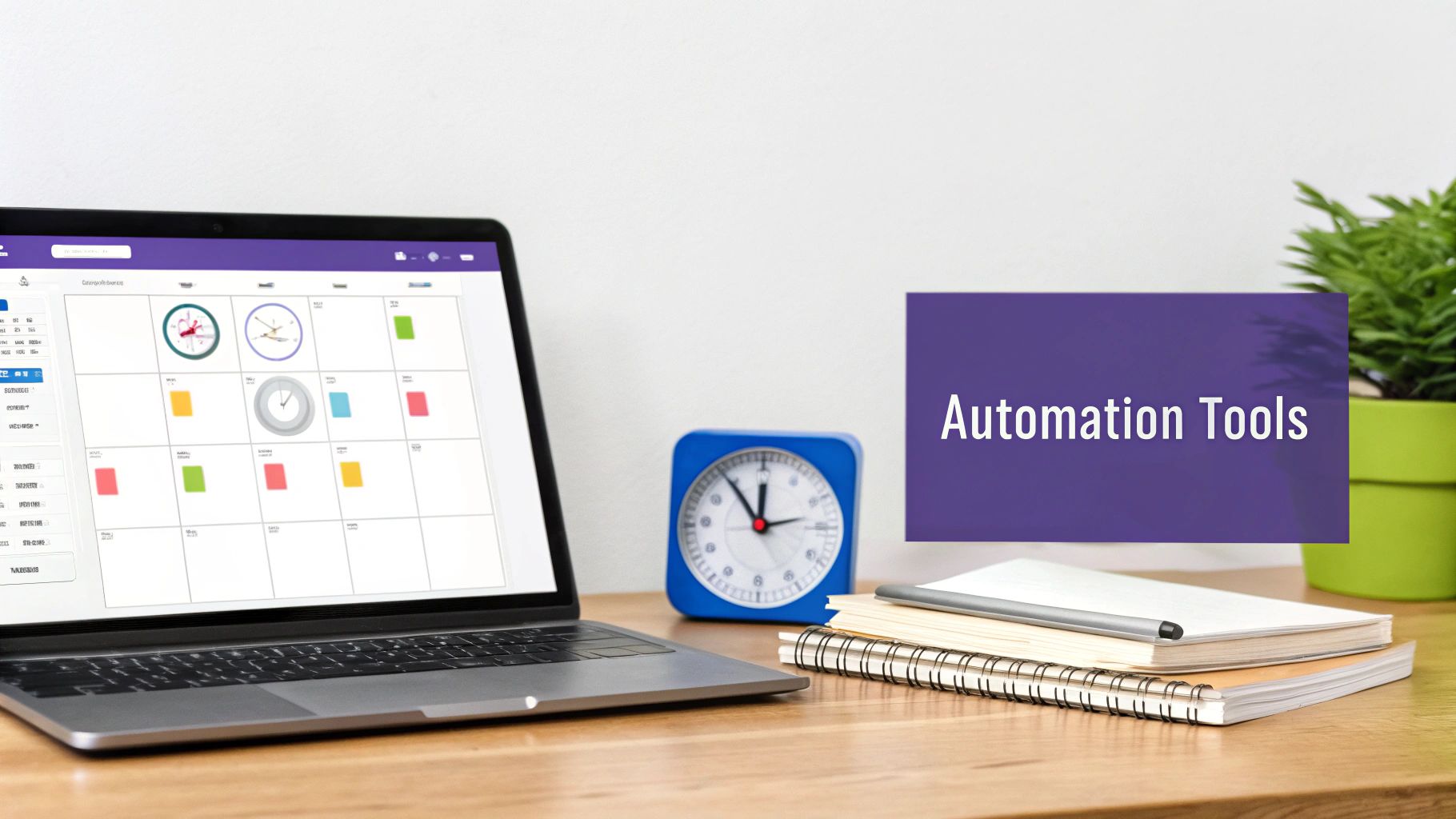
When your organic reach just isn't cutting it and earned media feels like a roll of the dice, paid channels offer a direct line to your audience. Think of paid distribution as a turbocharger for your content engine. It’s a strategic injection of cash to guarantee visibility and slice through the digital noise, putting your best work right in front of the people you need to reach.
This isn’t about just clicking "boost" and hoping for the best. A smart paid strategy is all about surgical precision. You can target users by their job title on LinkedIn, their exact search query on Google, or their personal interests on Facebook, making sure every dollar you spend has a purpose.
This kind of targeted power makes paid channels a must-have for a few key situations:
- Launching New Content: Give that new pillar post or research report the initial push it needs to get off the ground and gain organic momentum.
- Targeting High-Value Audiences: Reach specific decision-makers or niche customer segments that are almost impossible to connect with organically.
- Promoting Time-Sensitive Offers: Drive immediate traffic for things like webinars, limited-time deals, or event sign-ups.
By paying for placement, you transform your content from a passive asset sitting on your blog into an active tool that generates leads.
Defining Your Paid Campaign Goals
Before you spend a single penny, you have to know what success looks like. A paid campaign without a clear goal is like a ship without a rudder—it’s moving, but who knows where it will end up. Your main objective will shape which platforms you use, the ad formats you choose, and the metrics you obsess over.
Common goals for paid content distribution usually fall into a few buckets:
- Brand Awareness: Here, the goal is simple: maximize impressions and reach within your target demographic. You just want as many relevant people as possible to see your brand and your message.
- Lead Generation: This is all about capturing contact information. Success is measured by how many form fills, ebook downloads, or webinar sign-ups your campaign brings in.
- Driving Website Traffic: The mission is straightforward—get more qualified visitors to a specific blog post, landing page, or product page. You’ll measure this with clicks and click-through rates (CTR).
Choosing the right goal is the single most important step in setting your campaign up for a solid return on investment.
A successful paid strategy isn’t measured by how much you spend, but by how effectively that spend achieves a specific business objective. Aligning every ad with a clear goal like lead generation or traffic turns an expense into a measurable investment.
Choosing the Right Paid Platform
Once your goals are set, it's time to pick your battleground. Every platform has its own unique strengths, audience demographics, and targeting quirks.
Popular Paid Distribution Platforms:
| Platform | Best For | Audience Targeting |
|---|---|---|
| Google Ads | Capturing high-intent users actively searching for solutions. | Based on keywords, search history, and user behavior. |
| LinkedIn Ads | B2B marketing, reaching professionals by job title, industry, or company size. | Professional demographics, interests, and group memberships. |
| Facebook/Instagram Ads | B2C marketing and building brand awareness with visual content. | Based on detailed demographics, interests, and behaviors. |
| X (Twitter) Ads | Promoting timely content, joining trending conversations, and driving engagement. | Keyword targeting, follower look-alikes, and conversation topics. |
The fight for attention is fierce, and the numbers show it. Global digital ad spending is on track to hit $740.3 billion by 2025. In the US, Google and Facebook are the undisputed champs, controlling 38.6% and 19.9% of the market, respectively.
This just drives home how critical it is to be smart with your budget. With an average search CPC of $2.69 on Google, every single click has to count. For anyone using paid ads, understanding how to optimize Google Ads is essential to avoid wasting money. By aligning your content with the right platform and a clear goal, your paid campaigns become a powerful and scalable part of your entire content distribution strategy.
Harnessing Earned Media Through Trust and Relationships
While paid channels give you speed and owned channels give you control, earned media delivers something much harder to come by: genuine credibility. Think of it as the digital version of word-of-mouth—what people are saying about you when you’re not in the room. It’s the ultimate social proof, and it’s built entirely on trust and real relationships.
This isn’t something you can buy. It's publicity you earn by creating fantastic content, building a solid reputation, and giving people a compelling reason to talk about you. It's the natural result of a great owned media strategy and a true commitment to providing value. When others willingly share your story, it builds a level of trust that a paid ad just can't touch.
The real goal here is to strategically empower journalists, industry experts, and influencers to become your brand's advocates. And that takes a deliberate, relationship-first approach.
Generating Organic Publicity with Digital PR
Digital Public Relations (PR) is the modern engine that drives earned media. It’s about so much more than sending out a press release. It's about building real connections with the journalists, bloggers, and publications your target audience already follows and trusts. The key is to make their job easier by giving them amazing stories and valuable data.
A powerful tactic is to create content that’s just too good not to share. This usually looks like:
- Original Research and Reports: Conduct your own surveys or analyze data to uncover fresh industry insights. This immediately positions you as a go-to source that others will want to cite.
- Expert Commentary: Offer your unique take on trending topics in your niche. You’ll quickly become the expert source journalists call for a quote.
- Compelling Case Studies: Showcase real-world success stories that offer tangible proof of what you can do.
When you bring genuine insights to the table instead of just a sales pitch, you stop being a company begging for coverage and become a partner helping reporters create fantastic content.
Building Authentic Influencer Partnerships
Influencer marketing has become a huge part of earned media, but its real power is in authenticity, not transactions. We’re seeing a big shift away from one-off sponsored posts and toward long-term relationships with creators who genuinely vibe with your brand's values.
The most effective influencer collaborations are built on mutual respect and a shared belief in the product or message. When an influencer becomes a true brand advocate, their endorsement feels like a trusted recommendation from a friend, not a paid advertisement.
This approach means you have to be picky. Look for collaborators whose audience truly trusts their judgment and whose content style feels like a natural fit for your brand. The goal is to find partners who can weave your brand into their content seamlessly, making it a credible and organic experience for their followers.
The data backs this up, with a massive 59% of marketers planning to increase their influencer partnerships. This trend highlights a deeper understanding of social influence, where 76% of users say social content has influenced their buying decisions—a figure that skyrockets to 90% among Gen Z. You can discover more about how marketers are adapting to these trends and what it means for your strategy.
By focusing on trust and relationships, your earned media efforts become a powerful, self-sustaining machine that drives both credibility and incredible reach for your brand.
How to Build Your Distribution Strategy Step by Step
Let's get practical. Moving from theory to action is where a great content distribution strategy really comes alive. Building one isn't about guesswork; it requires a structured, thoughtful process. Think of it like building a house: you need a solid foundation, a clear blueprint, and the right materials for every part of the structure.
This framework will walk you through creating a durable and effective plan from the ground up, turning your content efforts into a predictable engine for growth.
Step 1: Define Your Audience and Goals
Before you share a single piece of content, you have to know who you're talking to and what you want to achieve. Without this clarity, you're just shouting into the void.
Start by creating detailed buyer personas that go beyond basic demographics. What are their biggest headaches? Where do they hang out online? What kind of content do they actually find valuable?
Next, set SMART goals (Specific, Measurable, Achievable, Relevant, Time-bound). Vague objectives like "get more traffic" are useless. Instead, you need concrete targets like:
- Increase organic traffic to our blog by 15% in the next quarter.
- Generate 50 marketing-qualified leads from our new ebook within the first month.
- Boost engagement on LinkedIn by 25% over the next six months.
These precise targets give your strategy a clear purpose and make it possible to measure what's actually working.
Step 2: Audit Your Existing Content
Your existing content library is an absolute goldmine. A content audit helps you figure out what to amplify, what to update, and what to leave behind. Don't just scan a list of URLs; really dig into the performance of each asset.
Look for these three things:
- High-Performing Posts: These are your proven winners. They already connect with your audience and are perfect candidates for paid promotion or repurposing.
- Outdated but High-Potential Content: Got a blog post with great bones but old stats? Update it with fresh data, give it a polish, and re-promote it as a brand-new piece.
- Underperforming Assets: Figure out why they fell flat. Was it the topic? The format? Poor initial distribution? This helps you avoid making the same mistakes twice.
This audit is also the perfect time to spot opportunities for repurposing. A single in-depth article can be spun into dozens of new assets. In fact, our comprehensive guide on creating a content repurposing strategy walks you through turning one piece of content into a full-fledged campaign.
This visual shows exactly how one article can be transformed into multiple formats to get more eyeballs on your work.
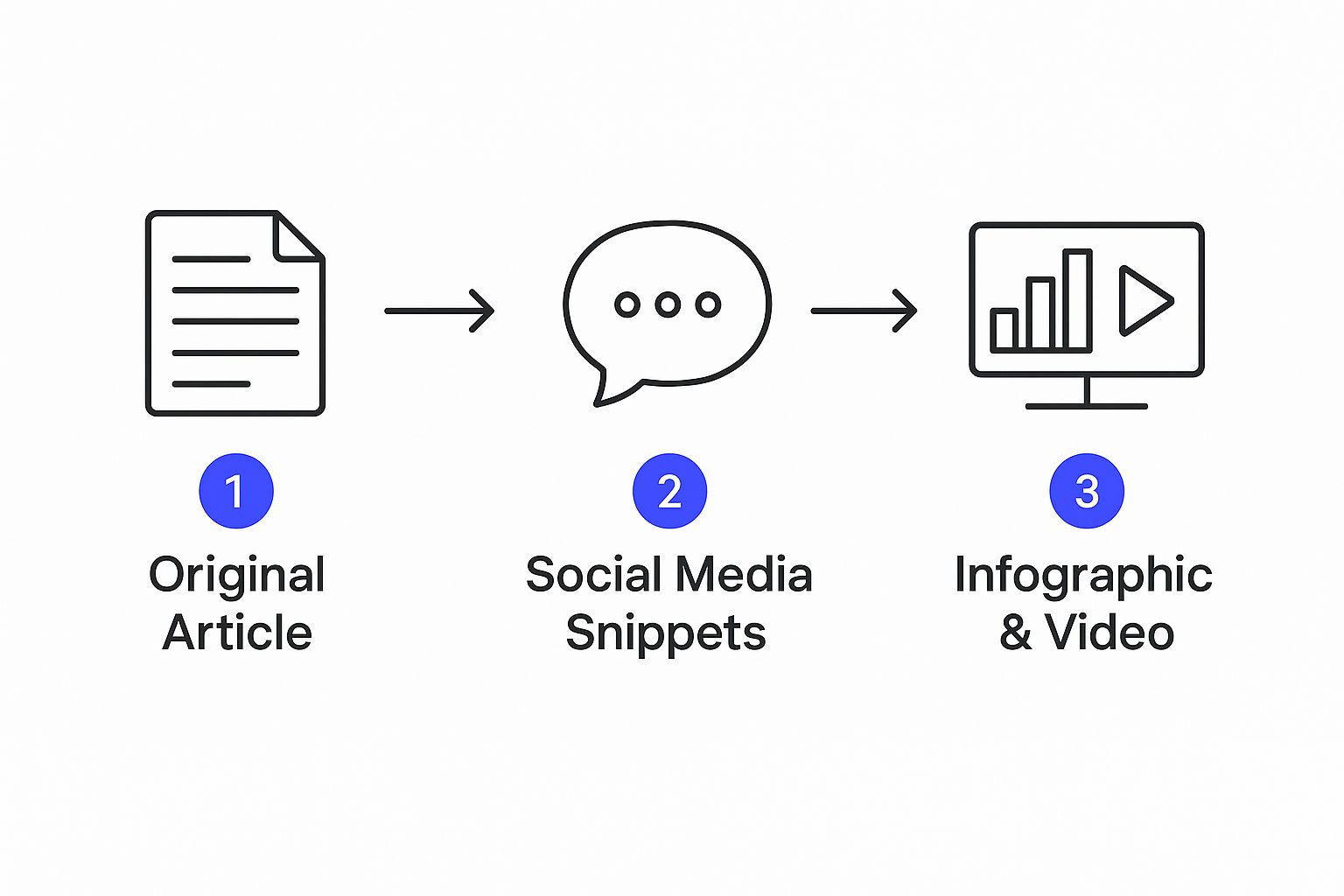
The key takeaway here is that you don't need to reinvent the wheel for every channel. Smart repurposing maximizes the effort you've already put in.
Step 3: Select the Right Distribution Channels
Now that you have audience insights and clear goals, you can choose your channels. Don't make the mistake of trying to be everywhere at once. Focus your energy on the platforms where your audience is most active and engaged. A B2B software company, for instance, will almost certainly find more success on LinkedIn than on TikTok.
A common mistake is chasing trends instead of your audience. The "best" channel isn't the newest or most popular one; it's the one where you can build a genuine connection with your ideal customer.
To make an informed decision based on your specific needs, a simple channel selection matrix can be incredibly helpful.
Content Distribution Channel Selection Matrix
Choosing where to focus your efforts can feel overwhelming. This table breaks down the strengths of a few key channels to help you match your goals and content to the right platform.
| Channel | Best For (Goal) | Content Format | Target Audience |
|---|---|---|---|
| Blog/SEO | Building long-term authority, capturing organic search traffic. | Long-form articles, guides, case studies. | Users actively searching for solutions and information. |
| B2B lead generation, establishing professional credibility. | Thought leadership posts, industry news, company updates. | Professionals, decision-makers, and industry peers. | |
| Nurturing leads, driving repeat engagement with loyal followers. | Newsletters, promotional offers, exclusive content. | An existing audience that has already opted in. | |
| YouTube | Visual storytelling, tutorials, building a brand personality. | How-to videos, product demos, interviews. | Audiences who prefer visual and educational content. |
By thinking strategically about where you post, you ensure your content lands in front of the people who need to see it most.
Step 4: Plan and Execute with a Calendar
Your distribution plan needs a schedule to keep everything on track. A content calendar is your command center for execution. It's so much more than a list of publication dates—it's a strategic tool for organizing your entire workflow.
A good calendar should include:
- The content title and its format.
- The primary channels for the initial push.
- The specific dates and times for promotion on each channel.
- The team member responsible for each task.
- Any notes on paid promotion or outreach efforts.
Tools like PostSyncer let you schedule everything in advance, ensuring a consistent and timely rollout across all your chosen platforms without any last-minute scrambling. This organized approach creates a steady drumbeat of content that keeps your audience engaged and your brand top-of-mind.
Follow these steps, and you'll build a repeatable system for getting your content seen by the right people, at the right time.
Measuring and Optimizing Your Distribution Efforts
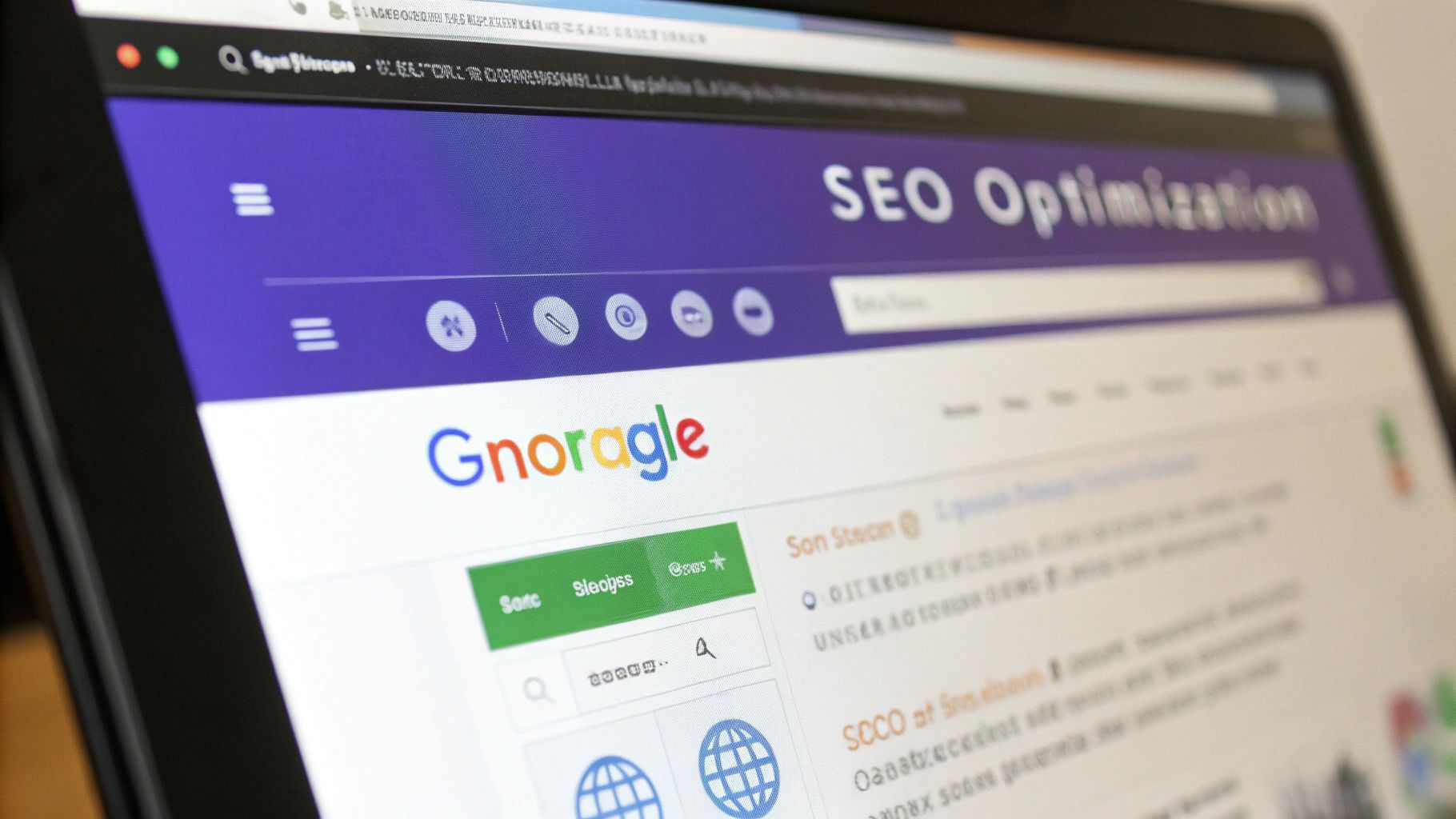
Let's be blunt: a content distribution strategy without measurement is just wishful thinking. It's like driving with your eyes closed—you're definitely moving, but you have no clue if you're actually getting closer to your destination. To make sure all your hard work pays off, you have to ask the tough question: "Is any of this actually working?"
This means looking past the vanity metrics. Sure, a million impressions might feel good, but if they don't translate into real business results, they're just empty calories. The real trick is tying every single metric you track back to your original goals.
Connecting Metrics to Business Goals
The goals you set should be the boss of the metrics you watch. A campaign designed to build brand awareness will have totally different key performance indicators (KPIs) than one built to generate leads. You need to pick the right data to tell the right story about your performance.
For brand awareness campaigns, you need to dig deeper than simple page views. Focus on metrics that prove you’re actually making an impact:
- Share of Voice (SoV): How much of the conversation in your industry does your brand own compared to your competitors? It’s your slice of the pie.
- Social Mentions: This isn't just about tagged posts. It's about how often people are talking about your brand organically across social media.
- Backlink Acquisition: Are other reputable sites linking back to your content? This is a huge vote of confidence and a powerful signal of authority.
When it comes to lead generation campaigns, the focus gets laser-sharp. Success here is all about how well you turn an audience into actual prospects.
- Conversion Rate: What percentage of people who saw your content took the action you wanted them to, like filling out a form or downloading a guide?
- Cost Per Acquisition (CPA): Plain and simple, how much money does it cost to get one new lead or customer from your efforts?
- Lead Quality Score: It’s not just about quantity. How many of the leads you're getting are actually a good fit for your business?
Getting a handle on these metrics is a must. If you want to dive even deeper, check out our guide on how to measure social media success.
Creating a Powerful Feedback Loop
Data isn't something you check once and forget about. It's the fuel for constant improvement. The insights you gather should create a feedback loop that helps you fine-tune your content distribution strategy over time, showing you what’s hitting the mark and what’s falling flat.
A truly effective content distribution strategy is not static. It is a living process of testing, learning, and optimizing. The goal is to consistently refine your approach for ever-improving performance.
This cycle of learning helps you make smarter moves. For instance, if you see a blog post getting tons of traffic but almost no conversions, maybe it’s time to test a new call-to-action. If LinkedIn consistently sends you high-quality leads, it’s a clear signal to double down on that channel.
By embracing this cycle of measuring and optimizing, you stop just doing things and start building a smart, results-driven system. This is how you guarantee your content delivers a real return on your investment.
Still Have Questions? We've Got Answers.
Got a few more questions rattling around about how to build a content distribution strategy that actually works? You're not alone. Here are some of the most common ones we hear from marketers just like you.
How Often Should I Actually Be Distributing My Content?
Here's the real secret: consistency beats frequency every single time. It's not about how often you post, but how reliably you show up for your audience.
A B2B brand might kill it on LinkedIn posting three times a week, while a B2C retailer might need that daily hit on Instagram to stay top-of-mind. The goal is to find a realistic rhythm you can actually maintain. It's far better to post consistently three times a week than to aim for daily posts, burn out in a month, and disappear. A content calendar is your best friend here—use it to map out a sustainable schedule.
What’s the Difference Between Content Distribution and Content Marketing?
It’s easy to get these two mixed up, but the distinction is critical. Content marketing is the entire game—the big picture of planning, creating, and sharing valuable stuff to pull in an audience.
Your content distribution strategy is a specific play within that game. It's all about the how, where, and when of sharing your content to make sure the right people see it. Think of it this way: content marketing builds the car, but distribution is the engine that actually gets it on the road.
You can have the most brilliant piece of content in the world (marketing), but without a solid plan to get it out there (distribution), it’s just going to sit in the garage collecting dust.
How Much of My Budget Should I Set Aside for Distribution?
While there's no single magic number, a great rule of thumb from seasoned pros is the 50/50 rule. The idea is to spend just as much time and money promoting your content as you spent creating it in the first place.
If you're just starting out and need to build that initial buzz, you might even flip this to an 80/20 split, pouring most of your resources into distribution to get the flywheel spinning.
Ready to stop guessing and start getting your content in front of the right people with precision? PostSyncer gives you the tools to schedule, automate, and analyze your entire social media workflow from a single, streamlined platform. Take control of your content distribution and start your free 7-day trial of PostSyncer today.
